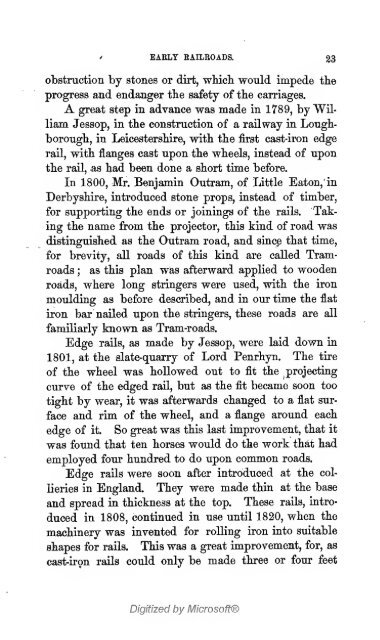The history of the first locomotives in America. From original ...
The history of the first locomotives in America. From original ...
The history of the first locomotives in America. From original ...
Create successful ePaper yourself
Turn your PDF publications into a flip-book with our unique Google optimized e-Paper software.
-• EARLY<br />
EAILEOADS. 23<br />
obstruction by stones or dirt, wHcli would impede tlie<br />
progress and endanger tlie safety <strong>of</strong> <strong>the</strong> carriages.<br />
A great step <strong>in</strong> advance was made <strong>in</strong> 1789, by William<br />
Jessop, <strong>in</strong> tlie construction <strong>of</strong> a railway <strong>in</strong> Lough-<br />
borougb, <strong>in</strong> Leicestershire, with <strong>the</strong> <strong>first</strong> cast-iron edge<br />
rail, with flanges cast upon <strong>the</strong> wheels, <strong>in</strong>stead <strong>of</strong> upon<br />
<strong>the</strong> rail, as had been done a short time before.<br />
In 1800, Mr. Benjam<strong>in</strong> Outram, <strong>of</strong> Little Eaton,' <strong>in</strong><br />
Derbyshire, <strong>in</strong>troduced stone props, <strong>in</strong>stead <strong>of</strong> timber,<br />
for support<strong>in</strong>g <strong>the</strong> ends or jo<strong>in</strong><strong>in</strong>gs <strong>of</strong> <strong>the</strong> rails. Tak<strong>in</strong>g<br />
<strong>the</strong> name from <strong>the</strong> projector, this k<strong>in</strong>d <strong>of</strong> road was<br />
dist<strong>in</strong>guished as <strong>the</strong> Outram road, and s<strong>in</strong>ce that time,<br />
for brevity, all roads <strong>of</strong> this k<strong>in</strong>d are called Tramroads<br />
; as this plan wias afterward applied to wooden<br />
roads, where long str<strong>in</strong>gers were used, with <strong>the</strong> iron<br />
mould<strong>in</strong>g as before described, and <strong>in</strong> our time <strong>the</strong> flat<br />
iron bar nailed upon <strong>the</strong> str<strong>in</strong>gers, <strong>the</strong>se roads are all<br />
familiarly known as Tram-roads.<br />
Edge rails, as made by Jessop, were laid down <strong>in</strong><br />
1801, at <strong>the</strong> slate-quarry <strong>of</strong> Lord Penrhyn. <strong>The</strong> tire<br />
<strong>of</strong> <strong>the</strong> wheel was hollowed out to fit <strong>the</strong> project<strong>in</strong>g<br />
curve <strong>of</strong> <strong>the</strong> edged rail, but as <strong>the</strong> fit became soon too<br />
tight by wear, it was afterwards changed to a flat sur-<br />
face and rim <strong>of</strong> <strong>the</strong> wheel, and a flange aroimd each<br />
edge <strong>of</strong> it. So great was this last improvement, that it<br />
was found that ten horses would do <strong>the</strong> work that had<br />
employed four hundred to do upon common roads.<br />
Edge rails were soon after <strong>in</strong>troduced at <strong>the</strong> col-<br />
lieries <strong>in</strong> England. <strong>The</strong>y were made th<strong>in</strong> at <strong>the</strong> base<br />
and spread <strong>in</strong> thickness at <strong>the</strong> top. <strong>The</strong>se rails, <strong>in</strong>troduced<br />
<strong>in</strong> 1808, cont<strong>in</strong>ued <strong>in</strong> use until 1820, when <strong>the</strong><br />
mach<strong>in</strong>ery was <strong>in</strong>vented for roll<strong>in</strong>g iron <strong>in</strong>to suitable<br />
shapes for rails. This was a great improvement, for, as<br />
cast-ifQu rails could only be made three or four feet<br />
Digitized by Micros<strong>of</strong>t®
















